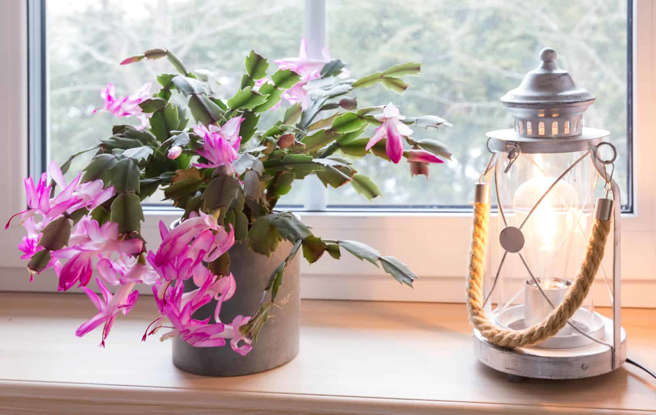Caring for a Christmas cactus requires attention to several key factors, including light, watering, fertilization, and pest management. Each element is crucial for ensuring the plant thrives and blooms beautifully during the holiday season. This guide offers practical strategies and insights to help you address common challenges in maintaining a healthy Christmas cactus, enabling you to enjoy its vibrant flowers year after year. Whether you are a beginner or looking to refine your care techniques, this comprehensive resource will equip you with the knowledge needed for successful cactus cultivation.
Table of Contents
Optimal Light Conditions for Christmas Cacti
Christmas cacti, scientifically known as Schlumbergera, are a beloved houseplant known for their vibrant blooms during the holiday season. One of the most crucial factors that contribute to the health and flowering of these plants is their light requirements. Understanding how to create the optimal light conditions for your Christmas cacti can significantly enhance their growth and flowering potential.
Understanding Natural Habitat
To provide the best light conditions for your Christmas cactus, it’s essential to start by understanding the plant’s natural habitat. Native to the tropical forests of Brazil, these cacti thrive under the canopy of trees where they receive bright, indirect sunlight. This understanding can guide you in mimicking their natural growing conditions indoors.
Lighting Requirements
- Indirect Light: Christmas cacti flourish in bright but indirect light. Direct sunlight can scorch their leaves and hinder blooming. A location near an east or west-facing window is often ideal, where they can catch the gentle morning or evening sun.
- Low Light Tolerance: While it is best to avoid low-light conditions, Christmas cacti are more tolerant of such environments compared to other houseplants. If they receive too little light, however, the plants may exhibit elongated stems and lackluster blooms.
- Duration of Light: Aim for about 12-14 hours of light exposure daily in the growing season (spring and summer). During the flowering period (typically late fall), maintaining a consistent light schedule can help stimulate bud formation.
Adjusting Seasonal Light Exposure
As the seasons change, so do the lighting conditions. During the shortened days of fall and winter, particularly as the plant prepares for its blooming cycle, you may need to adjust the position of your Christmas cactus:
- Supplemental Lighting: If your cactus isn’t getting enough natural light during winter months, consider using grow lights to supplement their light intake. LED grow lights are a great option, as they provide the necessary spectrum without overheating the plant.
- Rotation of the Plant: Regularly rotating your Christmas cactus ensures all sides receive equal light exposure, promoting a more balanced and bushy growth habit.
Signs of Inadequate Light
It’s vital to monitor your cactus for any signs of inadequate light, which can include:
- Leggy Growth: If your cactus appears stretched or elongated, it may be reaching for more light.
- Pale or Yellowing Leaves: Unusual leaf coloration can indicate light stress, signaling that your plant may need more indirect sunlight.
- Reduced Flowering: A lack of blooms can also suggest insufficient light exposure, especially as it approaches the holiday season.
Tips for Ensuring Optimal Light Conditions
Here are some practical tips to ensure your Christmas cactus receives the optimal light conditions:
- Monitor Light Levels: Use a light meter or smartphone app to measure the light intensity in your home, ensuring it’s ideal for your cactus.
- Avoid Drafts: Place your cactus in a stable environment away from air vents or doorways, where sudden drafts can disrupt its light exposure.
- Use Sheer Curtains: If placing your cactus near a window that receives direct sunlight, consider using sheer curtains to filter the light while still providing adequate brightness.
By carefully tailoring the light conditions for your Christmas cactus, you can help ensure it remains healthy and vibrant, ultimately leading to a stunning display of flowers when the holidays arrive. Understanding and addressing each aspect of its light requirements can make all the difference in achieving a flourishing plant that brings festive joy to your home.
For more insights on caring for your indoor plants, including detailed guides on caring for Christmas cacti, be sure to explore reputable gardening resources.
Watering Strategies for Healthy Growth
Watering is a critical component in the cultivation of healthy Christmas cacti. Unlike other houseplants, these unique succulents thrive on a specific watering schedule that caters to their tropical origins. Below are effective watering strategies that will ensure your Christmas cactus not only survives but flourishes.
Understanding Watering Frequency
The first step to optimal watering is understanding how frequently your Christmas cactus needs water. Generally, during the growing season (spring and summer), you should water your plant every two to three weeks, allowing the top inch of soil to dry out between waterings. In contrast, during the dormancy period (fall and winter), the frequency can be reduced to once a month.
Water Quality Matters
The type of water you use can significantly impact the health of your cactus. It’s recommended to use distilled or rainwater, as these options are free from chemicals like chlorine and fluoride that can be harmful to plants. If you must use tap water, let it sit out for 24 hours to allow any harmful substances to dissipate.
How to Water Effectively
To water your Christmas cactus effectively, follow these steps:
- Check the Soil: Stick your finger into the soil up to the second knuckle. If it feels dry, it’s time to water.
- Water Generously: When watering, thoroughly soak the soil until water drains from the bottom of the pot. This ensures that moisture reaches the roots, promoting healthy growth.
- Avoid Standing Water: Make sure to discard any excess water in the saucer after watering to prevent root rot.
Signs of Overwatering and Underwatering
Knowing the signs of overwatering and underwatering can save your cactus from stress:
- Overwatering: Yellowing leaves, a mushy texture, and mold growth on the soil surface are clear indicators of excessive moisture.
- Underwatering: If the leaves become shriveled and wrinkled, your cactus is signaling that it needs water.
Maintaining a balance is key: the goal is to hydrate without saturating.
Seasonal Watering Adjustments
Throughout the year, make seasonal adjustments to your watering strategy:
- Spring and Summer: Increase watering frequency as the plant actively grows during these seasons.
- Fall and Winter: Decrease watering; Christmas cacti may enter dormancy during winter, requiring less moisture.
Humidity Considerations
Christmas cacti thrive in environments with higher humidity levels. Low humidity can cause the plant to dry out faster, increasing the watering frequency requirement. Consider the following tips to enhance humidity levels around your cactus:
- Group your plants together to create a humid microclimate.
- Use a humidity tray filled with water and pebbles, placing your cactus pot on top.
- Regularly mist the leaves, especially during dry winter months.
Conclusion
Implementing these watering strategies will position your Christmas cactus for healthy growth and vibrant blooms. Be sure to adjust according to the plant’s needs and the seasons, and your cactus will thrive beautifully. As we transition to fertilization tips, consider how nutrition complements your watering strategy for even more robust plant health.
Fertilization Tips to Enhance Blooms
Enhancing the blossoms of your Christmas cactus (Schlumbergera) requires more than just proper watering and light. Fertilization plays a crucial role in ensuring your plant blooms beautifully, offering a vibrant display of color during the festive season. Below, we delve into effective tips for fertilizing your Christmas cactus, helping you achieve the lush, colorful flowers you desire.
Understanding Nutritional Needs
The first step to successful fertilization is understanding the specific nutritional needs of your Christmas cactus. These plants thrive on a balanced diet of essential nutrients, most notably:
- Phosphorus: Crucial for flower development, phosphorus helps stimulate blooming.
- Nitrogen: Important for overall plant growth, but should be used sparingly to avoid excessive foliage at the expense of flowers.
- Potassium: Supports root health and flower quality, enhancing the resilience of blooms.
Choosing the Right Fertilizer
When selecting a fertilizer, opt for a water-soluble formula with a balanced N-P-K ratio, ideally around 5-10-5 or 10-30-20. These ratios indicate a higher concentration of phosphorus, which is beneficial for flowering. Ensure the fertilizer is suitable for cactus and succulent plants, as they have specific dietary requirements compared to standard houseplants.
Timing Is Everything
Timing your fertilization is essential for promoting blooms. The ideal schedule is:
- **Pre-Bloom Period**: Start fertilizing your Christmas cactus in late spring or early summer. Make this a monthly routine until the blooming season begins.
- **During Blooming**: Reduce feeding frequency to every 6-8 weeks during the blooms. This helps conserve energy for flower production rather than excessive growth.
- **Post-Bloom Care**: After blooming, continue to fertilize sparingly to help your plant recover and prepare for the next growth cycle.
Methods of Application
How you apply fertilizer can affect its efficacy. Here are some techniques:
- Soil Application: Mix the fertilizer with water according to the package directions and apply it to the soil to ensure that nutrients reach the roots effectively.
- Top Dressing: For slow-release fertilizers, sprinkle the granules on the surface of the soil, keeping a distance from the plant’s stem to prevent burning the roots.
Signs of Nutritional Imbalance
Observing your Christmas cactus can help you identify signs of nutritional imbalance:
- Yellowing Leaves: This may indicate over-fertilization or a nitrogen deficiency.
- Poor Flowering: If the plant isn’t blooming as expected, it could be a sign of inadequate phosphorus.
- Stunted Growth: This might be a result of nutrient deficiency, often linked to inadequate fertilization.
Organic Fertilization Options
If you prefer organic gardening methods, consider natural fertilizer options such as:
- Fish Emulsion: This nutrient-rich option is high in nitrogen and promotes healthy growth.
- Bone Meal: A rich source of phosphorus, ideal for enhancing blooms and root growth.
- Compost Tea: Made from steeping compost in water, it provides a natural boost of nutrients without the risk of over-fertilizing.
Incorporating these fertilization strategies into your care routine will significantly enhance the blooming capabilities of your Christmas cactus. Remember that while fertilization is essential, it should be harmonized with other practices, such as proper watering and light conditions, to ensure your plant thrives.
For more in-depth insights into plant care, check out this Spruce article on feeding and caring for your Christmas cactus.
Pest Management for Vibrant Plants
Maintaining the health and vibrancy of your Christmas cactus goes beyond just proper watering and light conditions. Pest management plays a crucial role in ensuring your plants remain lush, thriving, and free from harm. This section will delve into effective strategies and preventive measures to keep pests at bay, enabling your Christmas cactus to flourish in your home or garden.
Identifying Common Pests
Before you can effectively manage pests, it’s essential to recognize the common culprits that may invade your Christmas cactus. Here are some pests to watch out for:
- Mealybugs: These small, white, fluffy insects often congregate in clusters and feed on plant sap, causing leaf drop and stunted growth.
- Spider Mites: Tiny red or yellow pests that thrive in dry conditions. They create fine webs and can cause a stippled appearance on leaves.
- Scale Insects: These pests can appear as small, brown or white bumps on stems and leaves, and feed on sap, leading to yellowing leaves and weakness in the plant.
- Aphids: Green or black, these small bugs are notorious for spreading diseases and can cause curled leaves and distorted growth.
Natural Pest Control Methods
For those looking to protect their Christmas cactus using environmentally friendly solutions, there are several natural pest control methods to consider:
- Insecticidal Soap: This product is effective against soft-bodied insects like mealybugs and aphids. Be sure to coat the entire plant, especially undersides of leaves, and repeat every few days until pests are gone.
- Neem Oil: Derived from the seeds of the neem tree, neem oil disrupts the lifecycle of pests when they try to feed on your plants. Dilute according to package instructions and spray every few weeks.
- Homemade Remedies: Create a simple spray using soap and water (1 tablespoon of mild soap per quart of water) to combat pest infestations. Spray in the evening to avoid leaf burn.
- Introduce Beneficial Insects: Consider introducing ladybugs or lacewings to your environment. These natural predators feast on aphids and other pests, helping maintain a balanced ecosystem.
Preventive Measures
Prevention is often the most effective strategy when it comes to pest management. Here are some tips to help you keep your Christmas cactus healthy and pest-free:
- Regular Inspections: Frequently check your plants for signs of pests or damage. Early detection can save your cactus from significant infestations.
- Proper Watering: Overwatering can create a favorable environment for pests and diseases. Ensure your cactus has well-draining soil and only water when the top inch of soil feels dry.
- Healthy Soil: Use nutrient-rich, well-aerated soil to strengthen your plant’s defenses. Adding organic matter can promote overall health and resilience against pests.
- Cleanliness: Keep the area around your plants free of debris and dead leaves, which can harbor pests. Regularly wipe off leaves to prevent dust accumulation.
When to Seek Professional Help
While many pest issues can be managed through home remedies and natural solutions, some infestations may warrant professional intervention. If you notice a significant decline in your plant’s health or a rapid increase in pest populations that your strategies aren’t addressing, it may be time to consult with a local nursery or pest control expert for more potent treatments.
By implementing a proactive approach to pest management, you can help ensure that your Christmas cactus remains vibrant and healthy throughout its lifecycle. Remember, a little attention can go a long way in preserving the beauty and vitality of your cherished plants.
For more detailed information on organic gardening techniques and pest management, consider visiting the U.S. Environmental Protection Agency’s pest management resources. To ensure a healthy and vibrant Christmas cactus, focus on optimal light, watering, and fertilization strategies. Position the cactus in bright, indirect light for 12-14 hours daily during the growing season, and consider using grow lights in winter. Water every 2-3 weeks in spring and summer, reducing to once a month during dormancy; use distilled or rainwater for the best results. Fertilize with a water-soluble N-P-K ratio of 5-10-5 or 10-30-20 monthly during the pre-bloom phase and every 6-8 weeks while blooming to support growth.
Monitor for signs of inadequate care, such as leggy growth or yellowing leaves, and identify common pests like mealybugs and spider mites. Use natural pest control methods, including insecticidal soap and neem oil, and maintain cleanliness around plants to prevent infestations. Regular inspections and a proactive approach can keep your Christmas cactus thriving and richly adorned with blooms during the holiday season.





